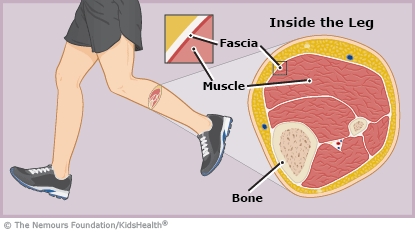Kids with chronic exertional compartment syndrome get temporary muscle pain when they exercise. The discomfort goes away when they rest.


The muscles, nerves, and blood vessels in our bodies are divided into 46 compartments. Each compartment is surrounded by fascia, a fibrous tissue.
When people exercise, their muscles expand. In some people who work out a lot, the fascia does not stretch enough to make room for this. The tight fascia squeezes the muscles, blood vessels, and nerves in the muscle compartment. Health care providers call this chronic exertional compartment syndrome.
Symptoms can include muscle tightness, cramping, aching, pain, or numbness. Symptoms usually start several minutes into a workout and go away soon after exercise stops. Each time the person exercises, the symptoms appear about the same time into the workout.
This condition is most common in high-level athletes who do repeating motions, such as runners, cyclists, and soccer players. It often affects one of the muscle compartments in the legs, but can happen in other parts of the body.
To make a diagnosis, the health care provider might ask your child to exercise for a bit and then check symptoms. Or the health care provider may use a pressure-testing device to find out if the fascia is squeezing the muscle too much.
Treatment includes rest, reduced exercise, or a change in the type of exercise. Physical therapy, stretching, or nonsteroidal anti-inflammatory drugs (NSAIDs) also might help. Sometimes, a health care provider may recommend surgery to reduce pressure on the muscle compartment.


Your child:

Your child: